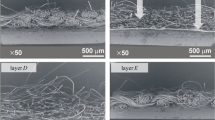Abstract
In this research, the thermoregulation behavior of layered arrangement of fabric containing microencapsulated phase change materials (mPCMs) is mathematically modeled based on a previously developed theoretical model of monolayer fabric—mPCMs. This work considers a thermal range for mPCMs instead of just a melting point. The skin temperature is calculated for a simulated situation when a person moves from 35 to 0 °C atmosphere. The results show that the location of layers containing mPCMs has the primary effect on skin temperature. This study defines the effectiveness intensity index (EII) and effectiveness time index (ETI) to describe the dynamic thermal behavior of fabric settings. The proposed model, which is also validated by experimental results, can be used to estimate the thermal behavior of clothing systems containing mPCMs and design protective clothing systems with proper dynamic thermal insulation for different climates. This study presents the model that can be useful for design the garment layers containing mPCMs. Due to considering the melting range instead of just melting point for mPCMs, it seems that this simple model can predict the thermal behavior of garments close to real condition.








Similar content being viewed by others
Abbreviations
- T :
-
Local temperature (°K)
- T skin :
-
Simulated skin temperature (°K)
- T min :
-
Minimum point of phase change zone (°K)
- T c :
-
High amplitude point of phase change zone (°K)
- T max :
-
Maximum point of phase change zone (°K)
- \({T}_{\infty }\) :
-
Environmental temperature (°K)
- \({u}_{\infty }\) :
-
Heat transfer coefficient close to environment (W/m2 °K)
- \({c}_{\mathrm{t}-\mathrm{s}}\) :
-
Total capacity of fabric in static state (without phase change process) (J/Kg °K)
- \({c}_{\mathrm{t}-\mathrm{D}}\) :
-
Total heat capacity of fabric in dynamic state (during phase change process) (J/Kg °K)
- \({c}_{\mathrm{f}}\) :
-
Heat capacity of fibers (J/Kg °K)
- \({c}_{\mathrm{pcm}-\mathrm{S}}\) :
-
Heat capacity of micro-PCM in static state (J/Kg °K)
- \({c}_{\mathrm{pcm}-\mathrm{D}}\) :
-
Heat capacity of mPCM in dynamic state (J/Kg °K)
- \({h}_{\mathrm{fu}}\) :
-
Heat of fusion of mPCM (J/Kg)
- \(K\) :
-
Conductive heat transfer coefficient of fabric (W/m °K)
- \({\rho }_{\mathrm{t}}\) :
-
Total density of fabric (Kg/m3)
- \({\rho }_{\mathrm{f}}\) :
-
Density of fibers (Kg/m3)
- \({\rho }_{\mathrm{pcm}}\) :
-
Density of micro-PCM (Kg/m3)
- \({\rho }_{\mathrm{core}}\) :
-
Density of core of micro-PCM (Kg/m3)
- \({\rho }_{\mathrm{shell}}\) :
-
Density of shell of micro-PCM (Kg/m3)
- \(\gamma \) :
-
Proportion of fibers in fabric
- \(\alpha \) :
-
Core/shell ratio of micro-PCM
- \(\dot{q}\) cons :
-
Heat flux generated from simulated skin
- \(\varnothing \left(T\right)\) :
-
Distributing function of temperature (dimension less)
- A curve :
-
Area of DSC curve
References
R. Ghafarian, R. Shemshadi, M. Gorji, E. Avazverdi, Text. Res. J, 7(5), 644 (2018)
H.R. Mattila, Intelligent Textiles and Clothing (Woodhead Publishing Limited, Cambridge, 2006)
X. Tao, Smart Fibres, Fabrics and Clothing (Woodhead Publishing Limited, Cambridge, 2001)
S. Mondal, Appl. Thermal. Eng 28, 1536 (2008)
F. Salaün, E. Devaux, S. Bourbigot, P. Rumeau, Thermochim. Acta 506, 82 (2010)
M. Gorji, M. Karimi, M. Rahimi Larki, A. Safavi, J. Appl. Polym. Sci. 134(17), 124 (2017)
K. Ghali, N. Ghaddar, J. Harathani, B. Jones, K. Ghali, Text. Res. J. 74(3), 205 (2004)
F. Salaün, E. Devauxa, S. Bourbigota, P. Rumeaud, Thermochim. Acta 506(1–2), 82 (2010)
C. Gao, K. Kuklane, I. Holmér, Ergonomics 53(5), 716 (2010)
C. Gao, K. Kuklane, F. Wang, I. Holmér, Ind. Air 22(6), 523 (2012)
A. Safavi, M. Amani-Tehran, M. Latifi, Thermochim. Acta 594, 16 (2014)
Q. Zhu, Y. Li, Text. Res. J 74(5), 447 (2004)
B. Ying, Y. Li, Y.-L. Kwok, Q. Song, International Conference on Information Engineering and Computer Science (2009).
A. Safavi, M. Amani-Tehran, M. Latifi, Thermochim. Acta 604, 24 (2015)
X. Zhang, X. Chao, L. Lou, J. Fan, Q. Chen, B. Li, L. Ye, D. Shou, Compos. Commun. 23, 100595 (2021)
Z. Kang, D. Shou, J. Fan, Int. J. Heat Mass Transf. 157, 119833 (2020)
Author information
Authors and Affiliations
Contributions
All authors have participated in (a) conception and design, or analysis and interpretation of the data; (b) drafting the article or revising it critically for important intellectual content; and (c) approval of the final version.
Corresponding author
Ethics declarations
Conflict of interest
The authors declare that they have no conflict of interest.
Rights and permissions
Springer Nature or its licensor (e.g. a society or other partner) holds exclusive rights to this article under a publishing agreement with the author(s) or other rightsholder(s); author self-archiving of the accepted manuscript version of this article is solely governed by the terms of such publishing agreement and applicable law.
About this article
Cite this article
Safavi, A., Gorji, M., Bagherzadeh, R. et al. A Mathematical Model for Dynamic Thermal Behavior of Multilayer Clothing System Incorporated with Microencapsulated Phase Change Materials. Fibers Polym 24, 4049–4060 (2023). https://doi.org/10.1007/s12221-023-00278-6
Received:
Revised:
Accepted:
Published:
Issue Date:
DOI: https://doi.org/10.1007/s12221-023-00278-6




